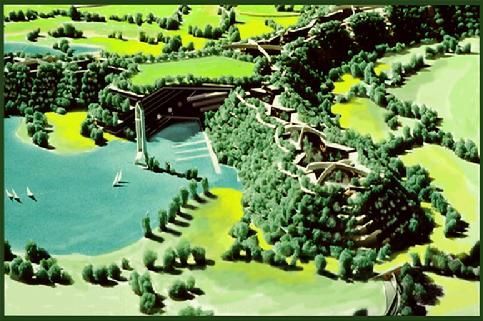Building New Land-use Designs
Creating land-use building designs for new modes of transportation

photo credits: ACROS, Fukuyama / Gene Zellmer, architect
Planning a new urban land-use for a mode of transportation that doesn’t exist yet, is synonymous with the phrase: ‘getting the cart before the horse’. Without knowing the design of the transportation mode’s vehicle, how can new ideas be formulated for its land-use? However, speculation for something new has to be acknowledged.
Sustainable urban growth
Inasmuch as transportation is the foundation to all urban growth, sustainability for land-use is the most important aspect for urban growth. This brings the question: how is its sustainability enabled? The political move to force society to remove plastic bags is irrelevant to sustainable urban growth. More relevant than political rhetoric, sustainable urban growth involves nature. Growing gardens, fresh water access and common sense are among the plethora of following nature’s course.
The primary concern for urban growth is enabling sustainability. Urban growth is built on transportation, it’s imperative that efficient energy use is implemented for transportation if urban growth is to be sustainable.
In 1983, the United Nations (UN) convened the World Commission on Environment and Development (WCED), which came to be known as The Brundtland Report. The conclusion of the report identified three aspects of urban growth:
- Environmental
- Economic
- Social
As the definition of sustainable development, Wikipedia states:
“The Brundtland Report was intended to respond to the conflict between globalized economic growth and accelerating ecological degradation by redefining "economic development" in terms of "sustainable development". It is credited with crafting the most prevalent definition of sustainability: "Sustainable development is development that meets the needs of the present without compromising the ability of future generations to meet their own needs."
The blogpost Sustainable Growth for Urban Development, shares information relating to sustainable urban growth.
In 1987, the UN debated the report which eventually led to the creation of the UN Commission on Sustainable Development in 1992. It grew into what is referred to as Agenda 21.
Key Features
- Locally implemented, globally impacting: Agenda 21 encourages local governments and communities to develop and implement sustainable development plans, which can then be scaled up to have a global impact.
- Property rights: The agenda acknowledges the importance of property rights, emphasizing that without them, there is no freedom.
- Sustainable development: Agenda 21 distinguishes itself from sustainable development, which is often used interchangeably. It is a plan of action for achieving sustainable development during the 21st century.
- Influence of NGOs: Non-governmental organizations (NGOs) played a significant role in shaping Agenda 21, particularly due to its non-legally binding nature.
- Focus areas: The agenda addresses various aspects, including:
- Combating pollution of land, air, and water
- Conserving and improving biodiversity
- Promoting socio-economic development
- Improving human settlements and urban planning
- Enhancing international cooperation and coordination
Purpose
Agenda 21 aims to provide a framework for achieving sustainable development and economic growth, while protecting the environment and promoting social justice. It serves as a blueprint for governments, organizations, and communities to work together towards a more sustainable future.
As the follow-up to Agenda 21 is the UN’s 2030 Agenda.
Philosophically, agenda setting is problematic for people who disagree with politically appointed rule makers who have placed themselves into such positions of power. There are indeed good people making good decisions. There are also many instances of narcissistic politicians having dominion above the rule of independence. Many such instances show that tyranny pushes social unsustainability into two social classes: rulers and slaves. This is the opposite of social sustainability for human life; disguised as social justice. Trust is earned, demands are questioned when spoken by liars and corrupted thieves.
The point here is to insist on providing a methodology for efficient and sustainable transportation; when adhering to questionable politically motivated agendas having more to do with social guidelines of governmental control to urban growth, that have nothing to do with transportation.
Current impacts of unsustainable urban growth
What are the impacts of the current state of unsustainable urban growth? The blogpost Sustainable Growth for Urban Development, defines the unsustainable impacts:
Environmental Impact
The automobile requires road surfaces. These roadbeds are oil based. Ever watched a road being built? Lots of grading work, scraping dirt, filling, and generally reworking the natural surface of Earth. Okay, not a big deal in small amounts, but tens of millions of miles of roads heavily effect the natural water flow of streams and runoff. Secondly, millions of miles of roadbeds capturing grease, emissions by-products, pollutants, carcinogens, and oil spills are funneled as oil canals called roadbeds flowing directly into the water basins. That is undoubtedly environmentally unsustainable. Millions of electric and autonomous cars won’t resolve the damage caused by the oil-based road infrastructure.
Economic Impact
Ever hear the phrase “buy local, spend local?” This term is what creates regional economic sustainability. A dollar spent locally allows that dollar to stay in circulation, being continually exchanged within a local area. When that money is spent out of the local area, the money is gone; it can no longer be used locally. Automobile-centric land-use design is economically unsustainable. Here’s why: the first product of economic unsustainability is the purchase of a new automobile. Today’s purchase price of an automobile is what, on average? $50,000? That amount is instantly removed from circulation in a local economy, never to be recovered for circulation in that community unless that car was manufactured in that local community. Then there are the fuel consumption rates. Averages vary from region to region. For example, a county consumes 500,000 gallons of gasoline per day. At $3 per gallon, that is $1.5 million per day (less 2 percent for the wholesaler and retailer) permanently extracted from ever being used and circulated in that community. An even greater financial extraction from the community are insurance costs per vehicle, at an average cost of $120 per month per vehicle. This is economic unsustainability from the design of automobile-centric urban land-use.
Social Impact
These aspects are rarely considered by studies, except by a very few stragglers engaged in nontraditional academia. It’s the cutting edge of far-reaching consideration. There was a term coined in the early 2000s called visual hostility. It was popularized then, not so popular now, due to the extent of its content. Visual hostility is found to describe blight. Scores of nonprofit organizations declared war on urban blight. The support money behind nonprofits came from big money interests that cashed in on government subsidized, low cost, low-income neighborhood gentrification near high value real estate areas. A lot of blight was erased within a few years. To elected politicians, like homelessness, urban blight no longer exists.
Unsustainable urban growth will continue as long as the automobile remains the primary source of transportation in Western Society.
Another blogpost regarding the impacts of the automobile centric land-use design says this:
Social
Here’s where things get odd. The style of an automobile is created by designers. Primary influences relevant to these designs are current trends in fashion. Car sales are promoted by advertising agencies’ campaigns exclusively measured by fashion trends to encourage customer purchases. While this is reasonable in business, its effects reach further than mere car sales in the automobile-centric society.
The date of every car manufactured can be visually ascertained by its style of that decade. Further reaching social implications of fashion can be seen in the patterns and styles of the tract housing built to accommodate automobile-centric urban growth. The houses built in the 1920s are different than those of the 1930s, 40s, 50s, etc., through newly built dwellings today; every decade can be visually distinguished in its style.
One of the negative repercussions from fashion-only production in the automobile-centric society is the consequence of worn-out parts. Trends in design no longer fashionable fade into a negative social enigma. Outdated tract homes and strip malls no longer in vogue stimulate economic activity to newer growth centers of sprawl development. The significance can be seen in every urban area that is several decades old.
As clothing fashion styles change from season to season, the automobile and tract house styles make major shifts every decade. Inasmuch as fashions quickly go out of date, each tract style becomes out of fad after a decade and a new tract house area becomes popular. The nature of automobile-centric society follows new trending patterns based on that era’s marketing popularity in cultural and sprawl development.
Conclusion
Again, transportation is the foundation to all urban growth. There can be no sustainable urban growth without changing the primary source of transportation for Western Society.
The conclusion to the social cry for transportation is: “Give me an alternative!”



